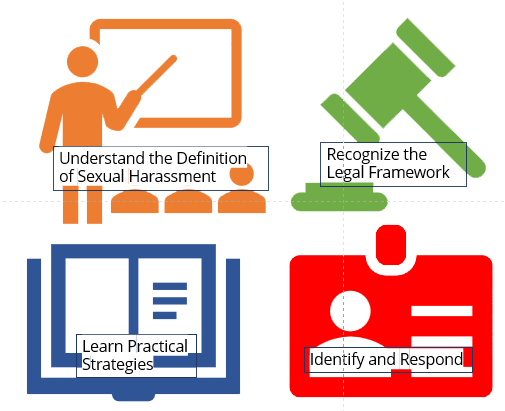What is Sexual Harassment?
Sexual harassment involves unwelcome behavior of a sexual nature that affects an individual’s dignity and creates a hostile, intimidating, or offensive environment. It can occur in various settings, including the workplace, educational institutions, and public spaces. It’s important to understand that sexual harassment is not just limited to direct interactions. It can also include actions that create a pervasive environment of discomfort or intimidation, even if the harassing behavior is not directed at a specific individual. Recognizing and addressing sexual harassment is crucial for maintaining a respectful and safe environment for everyone.
What are the Main Objectives of Sexual Harassment Prevention Training:
Sexual harassment prevention training aims to create a safer, more respectful environment by educating individuals on recognizing, preventing, and addressing sexual harassment. The main objectives of such training typically include:
- Understanding Sexual Harassment: Educating participants on what constitutes sexual harassment, including its various forms and manifestations.
- Recognizing the Impact: Highlighting the emotional, psychological, and professional impacts of sexual harassment on victims and the broader community.
- Promoting Awareness: Raising awareness about the prevalence and seriousness of sexual harassment in different settings, such as workplaces, educational institutions, and public spaces.
- Establishing Clear Policies: Informing participants about the organization’s policies and procedures regarding sexual harassment, including reporting mechanisms and consequences for violators.
- Encouraging Reporting: Empowering individuals to report incidents of sexual harassment without fear of retaliation and ensuring they know how and where to report such incidents.

- Developing Bystander Intervention Skills: Teaching participants how to recognize potential harassment situations and intervene safely and effectively to prevent or stop the behavior.
- Fostering Respectful Behavior: Promoting a culture of respect, dignity, and inclusivity by encouraging appropriate and professional behavior in all interactions.
- Ensuring Accountability: Emphasizing the importance of accountability at all levels, ensuring that everyone understands their role in preventing and addressing sexual harassment.
- Legal Compliance: Ensuring that the organization complies with relevant laws and regulations regarding sexual harassment prevention and response.
By achieving these objectives, sexual harassment prevention training helps create a safer, more respectful, and more inclusive environment for everyone.
Topics covered in Sexual Harassment Prevention Course:
- Sexual Harassment
- Types of Harassment
- Protecting Yourself
- Bystanders
- Retaliation
- Dealing with Harassment
This Sexual Harassment Prevention Course is designed to provide a thorough understanding of sexual harassment, including its legal aspects, preventive measures, and practical steps for addressing and reporting incidents. Its goal is to empower employees to foster a respectful and safe workplace environment.
Which laws require Employees to take Sexual Harassment Prevention Training
 Several laws in the United States require employees to undergo sexual harassment prevention training. Key laws include:
Several laws in the United States require employees to undergo sexual harassment prevention training. Key laws include:
- Title VII of the Civil Rights Act of 1964: While this federal law prohibits workplace discrimination, including sexual harassment, it does not specifically mandate training. However, the Equal Employment Opportunity Commission (EEOC) strongly recommends it as part of an employer’s efforts to prevent harassment.
- State-specific laws: Many states have their own requirements for sexual harassment prevention training. Some notable examples include:
- California: Under the California Fair Employment and Housing Act (FEHA), employers with five or more employees must provide sexual harassment prevention training to all employees. Supervisors must receive two hours of training, and non-supervisory employees must receive one hour, every two years.
- New York: The New York State Human Rights Law requires all employers to provide annual sexual harassment prevention training to their employees. New York City has additional requirements under the Stop Sexual Harassment in NYC Act.
- Connecticut: The Connecticut Human Rights and Opportunities Act mandates that employers with three or more employees provide two hours of training to all employees. Supervisors must receive training regardless of the number of employees.
- Illinois: The Illinois Human Rights Act requires all employers to provide annual sexual harassment prevention training to all employees.
These laws are designed to create a safer and more respectful workplace by educating employees on recognizing, preventing, and responding to sexual harassment.
Benefits of Sexual Harassment Prevention Law Compliance?
- Safe and Respectful Work Environment: Compliance with sexual harassment prevention laws ensures a workplace where all employees feel safe and respected. This promotes a positive work culture, enhances employee morale, and fosters mutual respect among colleagues.
- Enhanced Employee Well-being and Productivity: A harassment-free environment leads to increased job satisfaction and well-being for employees. When employees feel secure, they are more likely to be productive, engaged, and committed to their roles, which can result in higher overall productivity for the organization.
- Reduced Legal and Financial Risks: Adhering to sexual harassment prevention laws minimizes the risk of legal actions and the associated costs. This includes potential lawsuits, settlements, and fines, which can be financially draining and damaging to an organization’s reputation.
- Improved Reputation and Brand Image: Organizations that comply with harassment prevention laws are considered ethical and responsible. This improves their reputation among clients, customers, and potential employees. A positive public image can lead to better business opportunities and attract top talent.
- Retention of Talent: A respectful and safe workplace will likely retain talented employees. High turnover due to a toxic work environment can be costly in terms of recruitment and training expenses. Compliance with prevention laws helps maintain a stable and experienced workforce.
- Legal and Regulatory Compliance: Ensuring compliance with sexual harassment laws helps organizations avoid penalties and sanctions. It also keeps them updated with the latest legal requirements and industry standards, ensuring ongoing compliance.
- Encourages Reporting and Transparency: Effective implementation of harassment prevention policies encourages employees to report any incidents without fear of retaliation. This transparency helps address issues promptly and maintain a healthy workplace environment.
- Supports Diversity and Inclusion: Compliance with sexual harassment laws supports diversity and inclusion initiatives. By preventing harassment, organizations create an environment where diversity is valued and all employees, regardless of gender, feel included and respected.
- Promotes Organizational Accountability: Having clear policies and training programs in place demonstrates an organization’s commitment to accountability. It shows that the organization takes harassment seriously and is proactive in preventing it, thereby fostering trust among employees and stakeholders.
- Better Employee Relations: A commitment to preventing sexual harassment helps build stronger employee relations. When employees see that their employer is serious about creating a safe and respectful workplace, they enhance trust and loyalty toward the organization.
What are the Key Considerations When Choosing Insurance Policies:
- Scope of Coverage: Ensure that the policy explicitly includes coverage for sexual harassment claims, including defense costs, settlements, and judgments.
- Limits and Deductibles: Evaluate the coverage limits and deductibles to ensure they are sufficient to cover potential claims.
- Policy Exclusions: Be aware of any exclusions in the policy that might limit coverage for certain types of claims or scenarios.
- Third-Party Coverage: Consider whether the policy provides coverage for claims made by third parties, such as customers or vendors.
- Policy Endorsements: Look into any additional endorsements or riders that can expand coverage, such as for third-party liability or extended reporting periods.
By selecting the right combination of these insurance policies, companies can effectively manage the financial risks associated with sexual harassment claims and ensure comprehensive coverage.
Who Should Take the Sexual Harassment Prevention course?
Workplace harassment prevention courses benefit various individuals within an organization to ensure a safe and respectful work environment. Here are key personnel who should participate:
- All Employees:
- Employees at all levels: From executives to frontline staff, everyone should understand what constitutes harassment, how to recognize it, and their responsibilities in preventing and reporting it.
- New hires: It’s essential to onboard new employees with harassment prevention training to set expectations.
- Managers and Supervisors:
- Team leaders and supervisors: They play a critical role in fostering a respectful workplace culture and addressing any incidents promptly and effectively.
- HR professionals: Human resources personnel need comprehensive knowledge to develop and enforce policies, handle complaints, and conduct investigations.
- Executives and Senior Leadership:
- Company executives: They set the tone for organizational culture and should demonstrate a commitment to a harassment-free workplace.
- Board members: Directors should understand their oversight responsibilities regarding harassment policies and procedures.
- Legal and Compliance Personnel:
- Professionals in legal and compliance roles need in-depth knowledge of harassment laws and regulations to ensure the organization remains compliant and minimizes legal risks.
- External Stakeholders:
- Contractors and consultants: Individuals who work closely with the organization should be aware of and adhere to its harassment prevention policies.
- Clients and vendors: Companies may choose to extend training to external parties who interact with their employees.
Please note that Supervisors and Managers should NOT take this course. Our two-hour course educates them on their responsibilities in preventing and addressing harassment, handling complaints, and fostering a safe work environment.
Sexual Harassment Prevention Course Details:
- Avg Training Completion Time: 1 Hour
- Format: Online Self-Paced Training
- Access: Online Access for 60 Days
- Certificate of Completion: Yes
- Training Certificate Expiry: 2 Years
- Audio: Yes
- License: Single User
Why Choose Our Sexual Harassment Prevention Course?
Course Features
- 24 x 7 access from anywhere for self-paced online courses
- Course meets state and federal requirements
- Courses created by Experts in the industry
- Instantly print or download Nationally Recognized Certificates
- Complete your course in one hour and get a certification
- Online course with audio and PowerPoint slides for easy understanding of training
- American Disability Act (ADA) compliant course format and delivery
- Online courses compatible with Windows, Apple, iPad, and other tablets
- Spanish Version is available
- Group Discount available.
- Unlimited Phone and Email Support
Free Sexual Harassment Prevention Course for Students
We will offer this course free of cost to students in USA schools, Colleges, or Universities. Please contact us for instructions on how to access the course.
Enroll Today
By ensuring comprehensive participation in sexual harassment prevention training, organizations can foster a workplace where all individuals feel safe, respected, and empowered to address and prevent harassment effectively. Enroll in our Sexual Harassment Course today and empower your team with the knowledge and tools they need to maintain a harassment-free environment.
Please contact us for more information at Bob@training-hipaa.net or call (515) 865-4591.
Testimonials
- Great and simple to follow and understand.
Brandun Sical - This was a great learning tool(training) and very informative and will be useful to anyone and everyone.
Kimberly (Kay) Kegley - The course was very informative, it allowed me to get a clear understanding of the topic being discussed.
Celeste Moore - The course was designed to provide an information to prevent harassment at work.It was very informative.
TAMAR KHZAALI - Excellent training, learned new things.
Oscar Laureano - This training was direct and informative. Clearly explained and easily understood. Thank you!.
Tineja Danielle Leslie - Very Informative and Educational.
Patroy Quarry - It was good. training video was easy to follow. questions came directly from the video.
Cordaryl Meaders - Very resourceful and detailed training for everyday decency.
KAYODE POPOOLA JOHNSON
